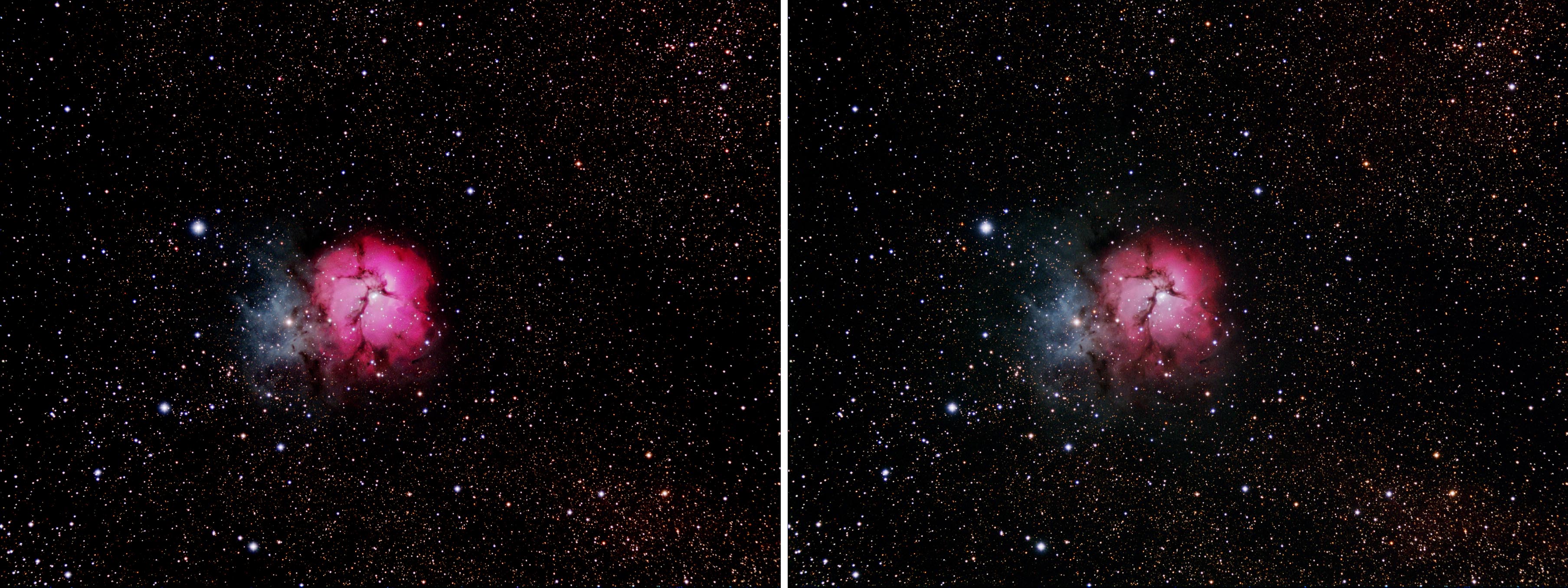
 | SOCO Blog |
9 September 2015
LETTING TRUE COLORS SHINE THROUGH
Thanks to persistent Summer Monsoon conditions here in the Southwest, astronomical imaging was pretty much a bust here at SOCO this August. I was only able to image on three nights in that month, and couldn't even do any stellar photometric studies. Looking back at the SOCO Log, I was able to image on 14 nights during August of last year. I've already missed my chances at targets I had hoped to image in Sagittarius and Scorpius. Now I'm looking at the fall constellations. Luckily, Cygnus will still be riding high in the sky for a while longer, so hopefully I can get some of the great objects in that constellation.
So, with no new images to blog about, I'll fall back on some of the older stuff. If there's one good result from the lack of imaging activity this month, it is that I've had time to work on some new image processing procedures. Among other things, I've (finally) been able to standardize my procedure for combining broad-band (Red, Green and Blue) images with narrow-band (Hα, Hβ and OIII) images to produce "hybrid" Red, Green and Blue Master Light Images that can be used to produce color composite images like those you can see on this website. Combining broad- and narrow-band images of astronomical targets is a common practice among astro-imagers. Narrow-band images are particularly useful in bringing out the details in emission nebulas, like the Orion Nebula (M 42), or planetary nebulas, like the Ring Nebula (M 57). This is because narrow-band filters are designed to pass light in only selected wavelengths, and these wavelengths are the ones in which the nebulas emit their light. Unlike stars, which emit light in all wavelengths, emission nebulas produce light in only a few selected wavelengths. So, using narrow-band filters "tuned" to these wavelengths, you can capture predominently the light of the nebula and exclude most of the other light, like from stars. This tends to be particularly useful in imaging faint nebulas (and many nebulas are relatively faint). Using narrow-band filters, you can image for long periods to bring out the details of the nebula without the surrounding stars being vastly over-exposed.
So, a common imaging practice is to collect two sets of images of a nebular target— a set of short-exposure broad-band (Red, Green and Blue) images and a set of long-exposure narrow-band (Hα, Hβ and OIII) images. In the broad-band images, the stars are nicely exposed but, often, the nebula is under-exposed (it may not even appear). In the narrow-band images, the nebula is nicely exposed, but the surrounding stars are under-exposed (many dim stars may not be visible). It would be nice to combine these two sets of images so that the stars in the resulting color image come from the broad-band images, while nebula comes from the narrow-band images. In the resulting color image, both the nebula and surrounding stars are nicely exposed.
As I indicated, many approaches have been proposed for combining broad- and narrow-band image sets to achieve this purpose. Aside from just throwing the images into Photoshop and arbitrarily mixing them until you get something you like, it would be nice to develop an objective procedure for combining broad- and narrow-band images. The big advantage of an objective procedure is that it works the same way each time and therefor produces consistent results. After a month of concerted effort, I have finally established a preliminary set of image processing steps that constitute an objective method for combining broad- and narrow-band images to produce "true color" images of astronomical objects (particularly emission and planetary nebulas). Details of the procedure are laid out in the Image Processing section of this website under Basic FITS Image Processing, Part II: Combining Broad-band (Red, Green, Blue) and Narrow-band (Hα, Hβ, OIII) Master Light Images.. In this blog entry, I'll show you the results of applying this procedure.
To demonstrate the results of using this procedure, I'll use a target that has appeared previously on this website. The Triffid Nebula (M 20) in the constellation Sagittarius combines an emission nebula with an adjacent reflection nebula, all set against the backdrop of the starry Milky Way. Back in June and July I was able to acquire sets of broad- and narrow-band images of this object. The broad-band (Red, Green and Blue) images were exposed for 90 seconds (1.5 min) each, while the narrow-band (Hα, Hβ and OIII) images were exposed for 900 seconds (15 min) each. As you can see, the narrow-band images were exposed 10 times longer than the broad-band images.
The right side of Figure 1 shows the result of combining the Master Red, Green and Blue Light Images to form a color composite image. This is the "standard" way of producing a color astro-image. The colors are correct in it and the stars are nicely exposed. The left side of Figure 1 shows the hybrid color composite image created by combining the Red, Green, Blue, Hα, Hβ and OIII Master Light Images. The stars in it are the same as in the standard version, and the bluish reflection component of the nebula is also the same between the two versions of the image. This is because, in producing the hybrid color composite, these features were taken from the Red, Green and Blue Master Light Images (which were used to create the standard version of the image). However, in the hybrid version, the pink nebula as taken from the Hα, Hβ and OIII Master Light Images. This results in the colors of the pink nebula being much more saturated than in the standard version. So, the pink nebula is really pink— almost unnaturally pink. However, this is the true color of the nebula— we just wouldn't normally see it this intense.

Figure 1. Trifid Nebula (M 20) in Sagittarius, (left) hybrid Red, Green, Blue, Hα, Hβ and OIII color composite, (right) standard Red, Green and Blue color composite.
This new approach to making hybrid color composite images is particularly effective in bringing out the colors of emission and planetary nebulas. I would have presented some additional examples, but the recent cloudy weather has kept me from acquiring more imagery. I'll try to show additional results in future blog entries, assuming these skies eventually clear!
 Return to SOCO Blog Page
Return to SOCO Blog Page
 Return to SOCO Main Page
Return to SOCO Main Page
Questions or comments? Email SOCO@cat-star.org